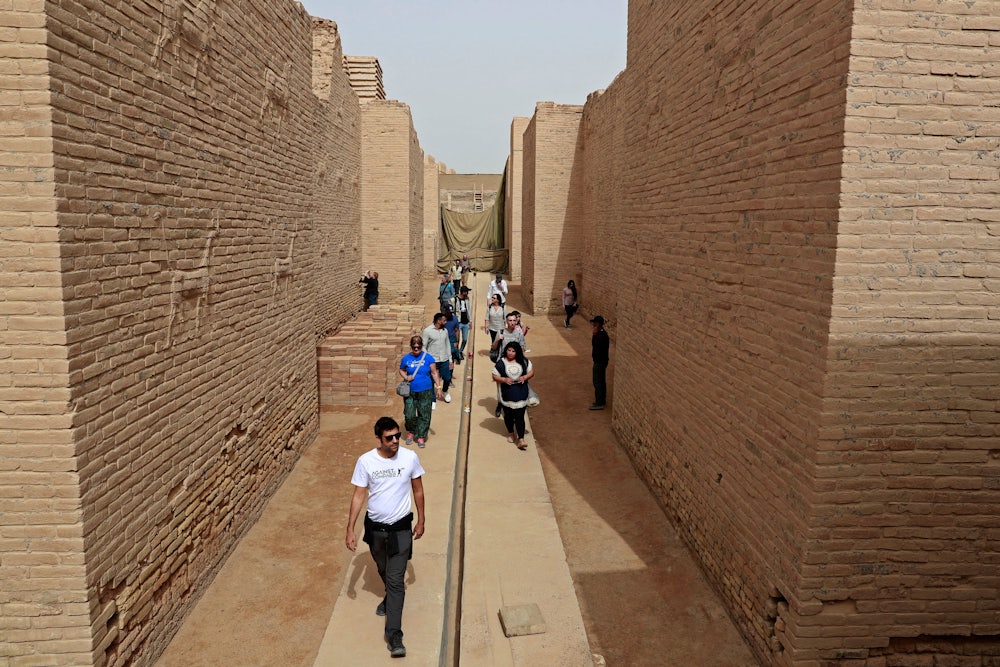In Iraq, higher temperatures and depleted freshwater resources have led to massive accumulations of salt in the ruins of Babylon. It burrows into the historic bricks, then cracks them from the inside out. In the Maldives, off the southwestern coast of India, rising sea levels threaten to overtake the 900-year-old Koagannu Mosques and Cemetery complex. And in Australia’s Murujuga peninsula, acidic pollution from industrial mining compromises 40,000-year-old carvings by steadily degrading the rock’s surface.
Climate change is threatening heritage sites the world over, as shown by these three stories plucked at random from major Western news outlets in recent months. While the mechanism of destruction varies, the message among archaeologists and activists in such stories is usually the same: We must act now to preserve these sites, before our shortsightedness destroys thousands of years of human history.
That message has instinctive appeal. Uncapped carbon emissions threaten every aspect of modern life, including our already fragile relationship to the past. But in plucking artifacts and architecture out of their context, these campaigns risk obscuring the most urgent consequences of climate change: that global warming is already killing people and is on track to kill countless more. And unlike war or any other disaster that has historically threatened heritage sites, climate change is global in scale. No community, living or dead, will be untouched.
For cultural heritage isn’t just about the past; every object is situated in an increasingly terrifying present. Groundwater depletion and rising temperatures threaten hundreds of thousands of living Iraqis, too. Current estimates suggest at this rate of warming, 80 percent of the Maldives will be uninhabitable by 2050, scattering climate refugees to distant shores. And rising temperatures and drought are already colliding in unprecedented Australian bush fires, which have killed dozens of people and an estimated one billion animals. The impulse to preserve may be a noble one, but the question remains: Who—or what—is really being protected?
The modern Western concept of “historic preservation” emerged in nineteenth-century England, when locals noticed that railroad tracks and stations were plowing through Norman castles, medieval churches, and ancient city walls. Parliament made the ruins of Berkhamsted Castle the first protected historic site in the country in 1833. The idea of proactively shielding sites from the march of time eventually spread to other countries too.
Preservation efforts mostly focused on sites of local importance. After World War II, however, policymakers began to formulate some of the first international conventions to protect cultural heritage in conflict zones. The landmark 1972 World Heritage Convention eventually committed signatories to conserving heritage sites within their borders on behalf of all humankind. The first World Heritage List followed in 1978. Today, it includes more than 1,100 sites globally.
/ In honor of Earth Day, Apocalypse Soon content is free to registered users until April 29. Start reading now.
It’s difficult to see the goal of cultural preservation as anything but enlightened. Yet in practice, it often reflects imperialist, Western, and capitalist biases. For one, not all World Heritage sites are treated equally: After a 2019 fire at Notre Dame Cathedral in Paris, international donors raised $1 billion for restoration seemingly overnight. But concern for antiquity didn’t stop then-President Donald Trump threatening illegal airstrikes against Iran’s cultural heritage sites, which include Persepolis and the historic city of Yazd, the following year. While Trump’s tweets were widely condemned, the mere threat reflected an implicit hierarchy of heritage—an invisible scale that makes the difference between what’s listed, what’s visited, and what’s protected at all costs.
And it’s not just about what deserves preservation but who is deemed capable of doing the work. Take, for example, the long-standing fight to repatriate the Elgin marbles to Greece. In the early 1800s, in an act considered audacious even at the time, Thomas Bruce, seventh Earl of Elgin, ordered his agents to plunder sculptures from the Parthenon in Greece and bring them back to England. Despite escalating pressure from activists, the artworks still reside in the British Museum. Of the many hollow-sounding arguments against repatriation of the Elgin marbles developed over the years, one stands out: Greece could not be trusted with its own art, some argued in prominent op-eds in the early 2000s, because Athens was polluted and the statues would be destroyed by acid rain.
The Elgin debate revealed just how easy it is for citizens of empire to confuse continued destruction for an act of protection. The sculptures were in fact quite badly damaged by the British Museum’s “preservation” work in the 1930s, yet the threat of future damage has been used to secure the museum’s continued ownership of the artifacts. The pace and scope of environmental destruction in recent years has only continued to complicate these matters. Today, wealthy onlookers are asked to donate to preservation campaigns in countries they may otherwise know little about. And while World Heritage sites exist in theory for far more high-minded reasons than tourism, in many cases, the global elite are also encouraged to continue traveling to threatened sites, in order to keep local economies running. In a warming world, articles like “7 Endangered Places You Should See Before It’s Too Late” hold a particularly romantic appeal—so long as readers can cope with the cognitive dissonance of the warming gases spewed through air travel. The inherent exploitation of these tourism economies, from the still-colonized island of Tahiti to the marginalization of Indigenous people of South America, is also conveniently overlooked.
This isn’t to say that cultural heritage sites don’t serve many noble purposes in the modern era. They do. For people on the ground, they may have continued spiritual or historical significance. So long as locals’ access and uses are prioritized over those of tourists, heritage status can be crucial for maintaining these spaces. There is also something to be said for the ideal of leaving artifacts to posterity; the short-term thinking that led us into the climate crisis must be combated, in part, by an investment in the future. But when a handful of powerful nations dominate the preservation efforts of the “rest,” the whole concept of human heritage ends up feeling almost like a globalized Nimbyism, where anywhere deemed exceptionally beautiful, unique, or irresolvable is territorialized as the West’s “backyard” to protect against threats real or perceived. Often, the living inhabitants—and broader notions of justice on today’s terms—are rather revealingly overlooked.
For all the political strife heritage sites can create, the path forward is mostly clear. Stolen artifacts must be repatriated. Historic sites must be protected—alongside the people who live and work in and around them. The view of world heritage sites as a universal good, rather than a very contextual inheritance, must be revised. And destinations of cultural or natural significance must continue to develop and implement innovative ways of protecting not just sites but citizens in a climate-changed era.
Here, Hawaii offers an appealing model: In late 2021, in response to the ravages of the pandemic, the state’s first majority–Hawaiian Native tourism authority announced a plan to shift away from marketing to “sustainable destination management,” according to Bloomberg. The plan has many moving parts, including reservations for high-traffic nature destinations, educational videos emphasizing cultural and environmental sensitivity, decolonial narratives about the history of the islands and its people, and incentivized volunteer opportunities for visitors who want to give back through beach cleanups and other activities. Perhaps most importantly, Oahu is also pushing for a new “regenerative tourism fee,” which would be levied upon each visitor and go directly to funding conservation efforts (similar strategies are also used in the Galapagos Islands, Palau, and Bhutan, which charges a daily $200–$250 tourism fee).
The questions such policies raise may be painful for those accustomed to viewing travel as not just a right but a moral act and world-renowned locales as “shared” social goods with (conveniently) local caretakers. Is the true purpose of a Hawaiian island to be a place “everyone” can enjoy, for the price of a plane ticket and hotel accommodation, or is it to sustain the bodies, minds, and spirits of Hawaiians? Should we “save” pieces of Murujuna from further decay by storing them in climate-controlled foreign museums, or should we decarbonize the global economy to provide a better life for the Aboriginal people of Australia living today? These may feel like false choices, and in some ways, they are—thought experiments to further illuminate our values. We can, in theory, have our cultural heritage and our humanity too. But every day without radical climate action drives the wedge between our ideals and our realities a little deeper. If things continue apace, we may one day be forced to choose.
There’s nothing wrong with the desire to connect with humans of the past—to marvel over the hands that carved the Elgin marbles or imagine those who first walked along the beaches of the Maldives. But as the decades-long debate over ethical tourism has shown, such experiences cannot come at the expense of the people who live in “destinations” year-round. And as the much-needed debate over ethical “preservation” will reveal, they can’t be meaningfully maintained without them, either.










